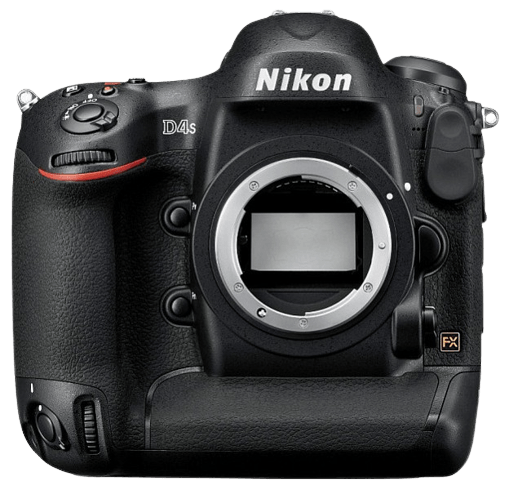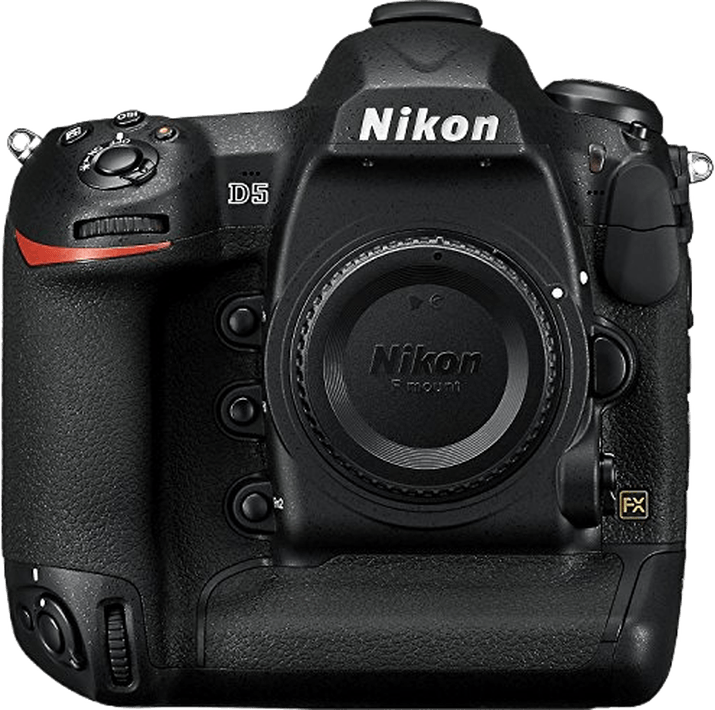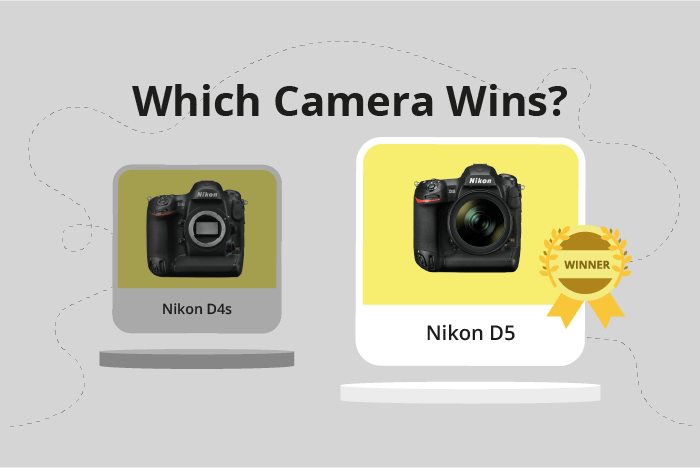Nikon D4s vs D5 Comparison
Nikon D4s

Nikon D5

The Nikon D5 outperforms the Nikon D4s with a score of 74/100 compared to 62/100. Both cameras share common features, such as being DSLR cameras, having a launch price of $6500, and similar dimensions, with the D5 being slightly larger and heavier. The D5’s higher score reveals its superiority in performance and overall quality.
The Nikon D5, released in 2016, offers improved specifications and features compared to the D4s, which was released in 2014. Despite being slightly larger and heavier, the D5’s advancements make it a more desirable choice for photographers seeking top-notch performance.
However, the Nikon D4s still has its merits, such as being lighter in weight, which can be an advantage for photographers who prefer a more compact camera. Though the D5 is the clear winner in terms of overall quality and performance, the D4s may still appeal to a specific group of users.
Taking all factors into consideration, the Nikon D5 stands out as the superior camera due to its advancements, while the Nikon D4s remains a viable option for those seeking a lighter and more compact DSLR.
Nikon D4s vs D5 Overview and Optics
The Nikon D5 surpasses the Nikon D4s in optics, scoring 72/100 compared to the D4s’s 62/100. Both cameras share several specifications, including a CMOS sensor, full-frame sensor size, Nikon F FX lens mount, and no image stabilization. Despite these similarities, the Nikon D5 outperforms the D4s in certain aspects.
The D5 boasts a higher megapixel count at 20.8, compared to the D4s’s 16.2, allowing for greater image detail and larger print sizes. Additionally, the D5’s Expeed 5 processor contributes to improved image processing, noise reduction, and overall camera performance. The D5 also edges out the D4s in shooting speed, capturing 12 frames per second compared to the D4s’s 11, making it slightly more suitable for action and sports photography.
However, the D4s has a higher DXOMARK score for its sensor at 89, compared to the D5’s 88. This indicates the D4s may have a slight advantage in dynamic range, color depth, and low-light performance. Nonetheless, the difference in DXOMARK scores is minimal and may not significantly impact real-world performance.
While the Nikon D5 proves to be the superior option in optics, the D4s remains a strong contender, particularly for photographers prioritizing dynamic range and color depth. The D5’s higher megapixel count, advanced processor, and faster shooting speed make it the more versatile choice for a range of photographic applications. Ultimately, photographers should consider their specific needs and preferences when choosing between these two capable cameras.
Nikon D4s vs D5 Video Performance
The Nikon D5 emerges as the winner in terms of video capabilities, despite both cameras having the same video score of 70/100. Both the Nikon D4s and D5 have several common features, including time-lapse functionality built in, which allows for creative video techniques.
The Nikon D5 outperforms the D4s in the area of video resolution, boasting 4K capabilities with a maximum video dimension of 3840 x 2160. This higher resolution allows for more detailed and sharper video quality, making it a better choice for professional videographers or those who prioritize high-quality video output.
On the other hand, the Nikon D4s offers a maximum video resolution of Full HD with dimensions of 1920 x 1080. While this resolution is not as impressive as the D5’s 4K capabilities, the D4s compensates with a higher maximum video frame rate of 60fps. This higher frame rate provides smoother video playback and is ideal for capturing fast-moving subjects or sports events.
Despite the D4s’s advantage in frame rate, the D5’s superior video resolution makes it the better choice for those prioritizing video quality. The 4K resolution offers a significant improvement in detail and clarity compared to the Full HD resolution of the D4s. However, for users who require a higher frame rate for specific shooting scenarios, the D4s may still be a suitable option. Ultimately, the choice between these two cameras will depend on the individual’s video requirements and preferences.
Nikon D4s vs D5 Features and Benefits
The Nikon D5 emerges as the winner in this comparison with a feature score of 74/100, while the Nikon D4s trails behind with a score of 57/100. Both cameras share some common specifications, such as a 3.2-inch screen size, the absence of a flip screen and GPS, and the presence of WIFI connectivity. However, the differences in their other features make the Nikon D5 a more superior choice.
The Nikon D5 boasts a significantly higher screen resolution of 2,359,000 dots, compared to the Nikon D4s’ 921,000 dots. This results in a much clearer and sharper display, allowing for better image preview and review. Additionally, the Nikon D5 is equipped with a touchscreen, which the Nikon D4s lacks. This enables easier navigation and quicker adjustments to settings, providing a more user-friendly experience.
The Nikon D4s has only one advantage over the Nikon D5, which is its lower price. This makes it a more budget-friendly option for those who are willing to compromise on certain features for the sake of affordability.
Taking into account the shared specifications and the individual advantages of each camera, it is evident that the Nikon D5 outperforms the Nikon D4s in terms of features. Its higher screen resolution and the presence of a touchscreen make it a more appealing choice for photographers seeking better image quality and convenience. On the other hand, the Nikon D4s may still be a suitable option for those with budget constraints, despite its lower feature score.
Nikon D4s vs D5 Storage and Battery
Both the Nikon D4s and D5 tie in storage and battery with a score of 87/100. They share common specifications, such as two memory card slots, accepting Compact Flash and XQD memory cards, and using the same EN-EL18a battery type. Neither camera offers USB charging.
The Nikon D5 outperforms the D4s in battery life, providing 3780 shots per charge compared to the D4s’s 3020 shots. This longer battery life makes the D5 more suitable for extended shooting sessions or situations where recharging may not be readily available.
On the other hand, the Nikon D4s does not have any distinct advantages over the D5 in terms of storage and battery. Both cameras have identical storage options and battery type.
Taking these factors into account, the Nikon D5 edges out the D4s in battery life, making it a more appealing choice for photographers who require longer shooting times without the need for frequent battery changes. However, both cameras offer reliable and efficient storage and battery performance that cater to professional photography needs.
Nikon D4s vs D5 – Our Verdict
Are you still undecided about which camera is right for you? Have a look at these popular comparisons that feature the Nikon D4s or the Nikon D5:

